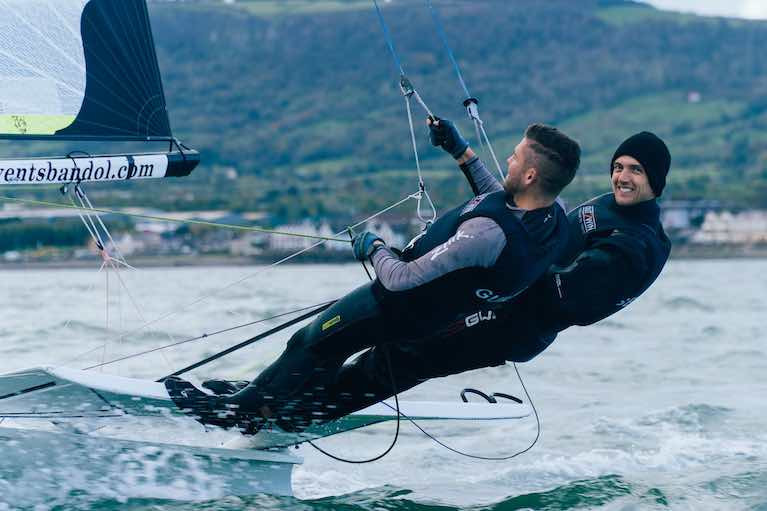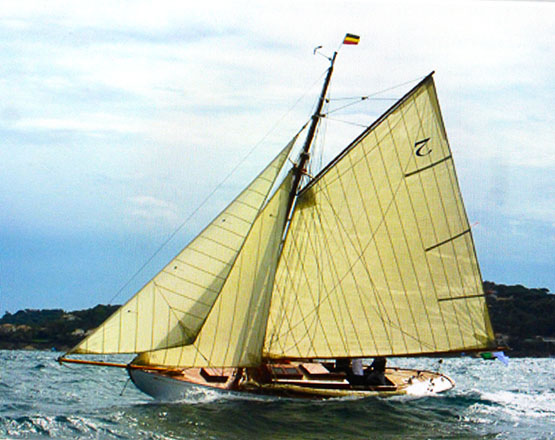Displaying items by tag: Carrickfergus Sailing Club
For Terry Windsor of Carrickfergus Sailing Club on the north shore of Belfast Lough, awards come in twos. Last year, he received an award from East Antrim Borough Council for Services to Sport in recognition of 28 years of service to local sailing. And recently, his club celebrated the many years of voluntary service the now retired Club Race Officer gave to Carrickfergus with a celebration after the Spring Series prizegiving.
Terry was presented with a keepsake album of images of the many successful boats he owned and helmed with numerous stories about his time with the Club and achievements and experiences recollected by past crew members.
The new clubhouse at Rodgers Quay (built to replace the building destroyed by fire in 2012) was reopened in 2014 by Terry who joined the club in 1955 and after 25 years as Chief Race Officer at Carrickfergus Sailing Club, now retires to enjoy a more relaxing time watching Club racing locally and in Scotland.
 Terry Windsor's successful 'Gumdrop'
Terry Windsor's successful 'Gumdrop'
After hanging up his sailing boots when his racing days finished, Terry spent many years on the Club’s Sailing Committee supporting younger sailors develop their skills and delivering successful events at the Club.
He held the important role of Chief Race Officer for the last 25 years. Overseeing the Club Battery, Terry was responsible for setting the courses for all club races including Regatta Days and for producing results for all club racing which would take place two or three times a week – an enormous commitment over the many years he has held this role.
Terry has owned and sailed many well-known cruiser racers after whetting his appetite in Flying Fifteens. His sailing career was successful both at home and in Scotland and notably punctuated with a dramatic rescue of a capsized J24 in the North Channel.
Terry’s friends expressed their gratitude “Thank you Terry, from all your friends at Carrickfergus Sailing Club for the momentous hard work you have consistently provided. We know we can call on you for advice anytime.”
Northern Ireland Olympian Ryan Seaton Says New Slipway at Carrickfergus Sailing Club is a 'Game-Changer'
Olympic sailor Ryan Seaton is back training at his home club in Carrickfergus on Belfast Lough following the completion of a slipway widening project.
In past campaigns Ryan has had to train away from home because the slipway at Carrickfergus was unsuitable for launching a high-performance dinghy.
Part-funded by Mid and East Antrim Borough Council, the new slipway means Ryan, who represented Ireland in the 49er Class at the London 2012 and Rio 2016 Olympic Games, can now launch safely and undertake his winter training on familiar waters for the first time as he bids for a place at next year's games in Tokyo.
With qualification for the much-anticipated competition just around the corner, Ryan and his crew, Seafra Guilfoyle from Royal Cork YC and University College Cork Sailing Club, are busy training and making plenty of use of the new slipway as Seaton aims for this third Olympics in a row. The duo competed in Austria at Lake Attersee last month to battle it out at the Europeans, as Afloat reported here.
 The newly widened slipway at Carrickfergus Sailing Club
The newly widened slipway at Carrickfergus Sailing Club
Ryan said "Carrickfergus and Belfast Lough is one of the best sailing locations throughout the UK and Ireland but I was unable to take full advantage of training on it due to the lack of a slipway suitable for my dinghy. This new facility is an absolute game-changer for me and will make a huge difference as I can now continue my professional sailing career at my home club and complete some vital training ahead of Tokyo 2021 qualification".
He continued "My thanks are extended to Carrickfergus Sailing Club and Mid and East Antrim Borough Council for making this possible and improving my training opportunities."
Mayor of Mid and East Antrim, Councillor Peter Johnston said the initiative will be a boost to the entire sailing community. "As a Council, we are proud to be able to assist with this very worthwhile project and wish Ryan every success as he aims for next year's Olympic games. This new feature is a boost to both the Club and other users and will hopefully inspire others to get involved and may even produce a few future Olympians."
RYA NI to Stage Sailing Club Conference in December
The RYANI annual affiliated club conference on Belfast Lough will take place this year on Saturday 2nd December 2017 at Carrickfergus Sailing Club. It is open to all RYA affiliated clubs to come and hear updates from the RYANI, including an update on the Insights Data from a recent club census.
Delegates can take part in a wide range of workshops, from becoming an RYA Training Centre to growing racing activity, running Honda Youth RIB events to improving your Club’s website/social media, to a workshop about an effective committee, plus many more. The day runs from 9.15am-5pm.
The event is sponsored by RYA membership and Sport NI Lottery fund.
The event is being run earlier than normal as feedback from previous conferences indicated clubs had little time to put into action new ideas gleaned from the conference.
Active Clubs Coordinator Lisa McCaffrey said: “The Affiliated Club Conference is a great opportunity to network with other clubs, learn and share ideas for the coming season and to gain more information on what the RYANI aim to achieve.
For more information contact [email protected]
Belfast Lough Sailing Story Seen In A New Light After Princess Anne Gives Royal Lead
Maybe it’s time and more to see sailing and its story – and particularly the complex history of Irish sailing north and south – in a new light. This year, the historical sailing focus is on Northern Ireland, where the Royal Ulster Yacht Club and Carrickfergus Sailing Club are both celebrating their 150th Anniversaries. For RUYC, this has already resulted in a Royal visit in recent days. But it was a Royal visit with a difference. W M Nixon takes a look at how the sailing celebration scene in Northern Ireland is reflecting an increasingly nuanced interaction with our sailing history, and how this in turn can affect how we interpret the story of sailing.
It was certainly a Royal visit with a difference, as it usually is with Princess Anne. Whatever your views on Royalty in any of its manifestations, purposes and functions, it has to be accepted that this is one very hard-working member of the British Royal family. When she’s President or Patron of some national or international organisation, it will almost inevitably be because she’s personally interested in the activities involved. And being an involved and can-do person, rather than a stand-aloof sort of figurehead, you’ll find that she was, and probably still is, a very enthusiastic participant in at least some specialized activity within the broad spectrum of the organisation’s remit.
Thus the fact that she and her husband are keen cruising enthusiasts who have in recent years moved up to the Rustler 44 Ballochbuie – which they base in Scotland - after many years with a Rustler 36, means that her role as President of the Royal Yachting Association is something with real meaning. When she goes to a yacht or sailing club, while inevitably there’ll be that slightly giddy mood which always accompanies the presence of Royalty, there’s no escaping the fact that this is a working visit. It’s a long way from being purely ceremonial – people find themselves talking about their own sailing, and sailing in general, both how it is run, and where it is going.
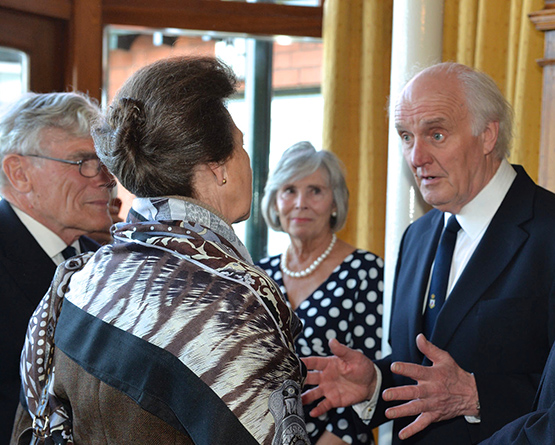
Serious business. Princess Anne in earnest discussion with Gordon Finlay, RUYC Honorary Archivist. On the left is Peter Ronaldson, former Vice Commodore RUYC and former Commodore Irish Cruising Club.
This isn’t the first time in Ireland north and south that Irish sailing has experienced the inspirational results of involvement by the Princess Royal. Twelve years ago, early in 2004, Afloat and the ISA got the word that a Big Idea floated some time earlier might just have wings.
In those days, our annual “Sailor of the Year” and “Sailors of the Month” awards were on a much more commercial basis, as they were strongly sponsored by Cork Dry Gin. It may now seem light years away, that a drinks company could so publically sponsor a major sports awards ceremony. But such was the case – they’d been doing it since 1996.
By 2004 it had become a very smoothly-organised affair, staged in the Irish Distillers Jameson Centre in Dublin where they even have a usefully-sized theatre/cinema which was ideal for this ceremony, and very efficiently organized as an event with Deirdre Farrrell, Irish Distillers’ in-house PR person, skillfully pulling it all together. Afloat and the Irish Sailing Association provided the details on who got what in the awards area, and Paddy Boyd, Secretary General of the ISA, performed as an extremely competent Master of Ceremonies while my job in concert with David O’Brien was to enumerate each of the citations for the usual multiplicity of awardees.
Thanks to the enthusiastic and directly-involved support of the sponsors, this annual show became such a byword for a well-run and popular yet efficiently-controlled event that we found ourselves playing a role in the much wider national and international scene.
The often difficult relations between the Republic of Ireland and Britain had started to thaw quite markedly after the Good Friday Agreement of 1998, and it was obvious that for this normalization process to continue to develop in a meaningful way which would have a resonance for many points of view within Ireland, in due course a Royal Visit to Ireland by the Queen would have to be on the cards.
So the buildup towards such a visit was set in place with quiet appearances at some relatively low key events – international charities were very useful for this – by some minor members of the Royal Family. The process then moved on, and when someone in the ISA/Afloat setup suggested that in order to add that extra zing to the annual Irish sailing awards, we should ask the Princess Royal in her capacity as President of the UK’s Royal yachting Association to do the honours, ISA President John Crebbin and Paddy Boyd made a discreet enquiry to the British Embassy, and found they were pushing at an open door.
Irish sailing’s idea fitted in very neatly with the development and implementation of improvements in Anglo-Irish relations. In a remarkably short space of time, what had been shaping up as the usual awards ceremony at Irish Distillers in February 2004, to present the gongs for 2003 including Sailor of the Year, had been re-shaped as a Royal occasion, while retaining the basics of the proven annual ceremony to provide an event in which everyone could feel at ease.
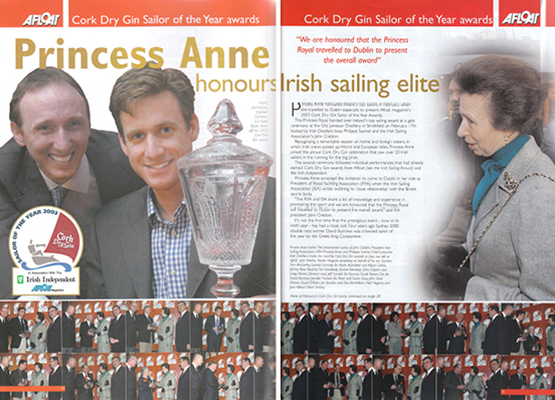
Back in February 2004, Irish sailing was given the Royal treatment in Dublin
For that’s what happened. It all went as smooth as clockwork. Deirdre Farrell was in her element keeping it all nicely but gently under control, while Paddy Boyd’s outlining of Royal protoocal beforehand, and his smooth running of the on-stage happenings, would have made you think he had a second life as some sort of big cheese in the United Nations.
As our double-page spread from the March 2004 Afloat suggests, just about everyone was there, they all had their chance of a word or two – and sometimes many – with the Royal President of the RYA, and then we had to canter through a multiplicity of awards with more appropriate words on stage at each juncture, followed by the presentation of the top trophy, which for 2003 was a double, as it was for Noel Butler and Stephen Campion, new World Champions of the International Laser 2 Class.
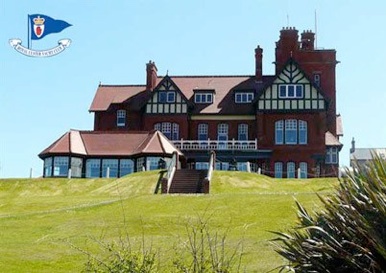
The RUYC clubhouse was built in 18 months in 1898-1899
The Princess Royal’s visit this past week to the Royal Ulster clubhouse in Bangor was a very different affair, as she was honouring the clubhouse as much as the club and the history to which it is home. In fact, the RUYC carries so much history that you’d wonder they aren’t burdened with it. But they wear their sometimes colourful past remarkable past lightly, for the creation in Bangor, over an ongoing process since 1984, of one of Ireland’s largest marinas, with all amenities including a boatyard, has meant that Belfast Lough and in particular Bangor sailing can move confidently through the present and on into the future, as dinghy sailors’ needs are superbly met by Ballyholme Yacht Club on the most easterly of Bangor’s notable bays.
This means that while today’s Bangor sailors can see the two clubs of RUYC and BYC as the natural focal points which meet their contemporary social needs, in the case of the RUYC clubhouse, it can double as a really remarkable sailing museum. Among other things, it includes the Lipton Room, filled with fascinating memorabilia of the hyper-energetic millionaire Thomas Lipton, who made no less than five challenges for the America’s Cup through the RUYC between 1899 and 1930.
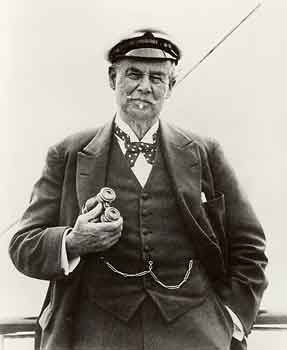
The eternal challenger – Thomas Lipton campaigned for the America;s Cup five times through the RUYC between 1899 and 1930
For the Royal sailing visitor, study time in the Lipton Room provided a vivid insight into one aspect of RUYC history. But then, after the meeting and greeting session with a diversity of members including RUYC Archivist Gordon Finlay and RUYC Historian Ed Wheeler, who are battling with a mountain of incredible material, the visit to the club was rounded out by the presentation to the Princess Royal by Vice Commodore Myles Lindsay of a legendary cruising book which she assured everyone will be going straight into the bookshelf aboard Ballochbuie.
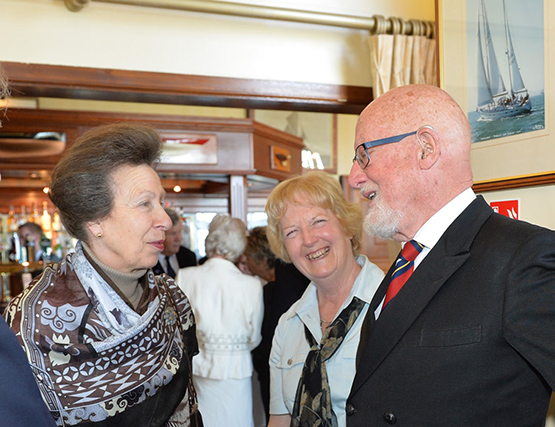
RUYC Historian Ed Wheeler with his wife Jan in a lighter moment with the Royal visitor
The immediately-cherished book was Letters from High Latitudes, published in 1856 as an account of the voyage by Lord Dufferin (his family seat is Clandeboye near Bangor) to Iceland, Jan Mayen and Spitzbergen in the schooner Foam. It has long been a classic of cruising literature, and it still reads today as crisply as though it was written only last week. For Frederick Temple-Hamilton-Blackwood (1826-1902), who eventually became the Marquess of Dufferin & Ava, was a very able sailor and navigator in addition to being a noted diplomat and imperial administrator and excellent raconteur..
So when a few Belfast Lough sailors got together to form the Ulster Yacht Club in 1866, naturally they asked the local national sailing celebrity, this special man who had voyaged to Iceland and beyond ten years earlier, to become its first Commodore, and he in turn ensured that the new club of which he was senior officer became the Royal Ulster YC in 1869.
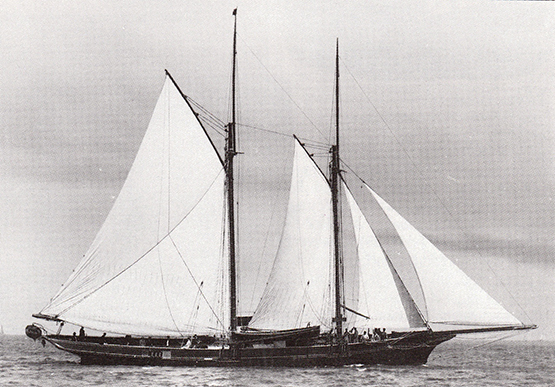
Lord Dufferin’s Foam, which he sailed to the High Arctic in 1856. He was Commodore RUYC 1866 to 1902.
At first they did without a clubhouse as the sought to serve all the more significant sailors throughout the north of Ireland. But by 1872 they rented some premises on Bangor seafront, and then in 1876 they took a lease on a substantial if semi-detached house on an eminence above the eastern side of Bangor Bay.
By the late 1880s and early 1890s, sailing in Belfast Lough was beginning to take off with local confidence, for before that leading northern sailors such as Henry Crawford with the cruiser-racing yawl Nixie, and John Mullholland - later Lord Dunleath - with the schooner Egeria, had tended to cut a dash elsewhere, Crawford on Dublin Bay, and Mulholland also on Dublin Bay, but even more so in the Solent.
However, by 1890, things were changing very rapidly to bring Belfast and Belfast Lough to the forefront of sailing, and this year’s 150th Celebrations at both Carrickfergus and Bangor – the official title is “Sesquicentennial”, since you ask – make us want to know more.
We’re going through such a plethora of major anniversaries these days – both national and international – that it’s natural there should be growing public interest in the story behind the story, the in-depth background to the history. We now want to know more about some great event way beyond the fact that it merely happened at a certain date, and that by doing so it had some significant outcome.
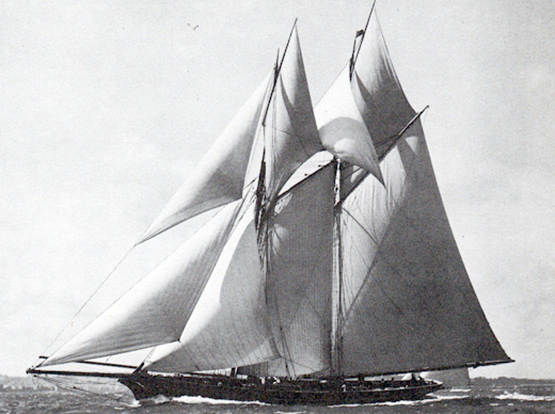
The much-travelled and very successful racing schooner Egeria was built in 1865 for John Mulholland. The following year, he became the first Vice Commodore of Royal Ulster YC
It may well be that one of the reasons sailing is a sport which is lacking in general public resonance is because histories of sailing have tended to concentrate on the narrow narrative of the development of the sport, and the boats it inspires. As for information on the sport’s administrative history, this tends to be no more than closely focused accounts of how clubs and national organisations emerged to meet the growing demands of this new recreational activity, without setting such developments in a broader framework.
Of course, there are many people who go sailing simply to “get away from it all”, for it’s an activity so different from shore life that the mere fact of being on a boat which is sailing is to be conveyed into another world. Such people may well prefer that the history of their beloved escapist sport is kept aloof from the socioeconomic circumstances in which it exists, and the context in which it developed.
But for others, it enriches our experience of sailing to know how it came to be as it is today, and this year in Northern Ireland there are sailing events and commemorations taking place which, when their back-story is analysed in some depth, give us a much better understanding of the way we live today, and how we go afloat today, and it is in turn all set in a meaningful way in the context of the general historical narrative.
In the case of Belfast in 1890, it was suddenly becoming the Mumbai of its day. It may have been the most air-polluted industrial city in the world, but my word they didn’t linger when doing things, as they had the world’s biggest shipyard, the world’s biggest engineering works, the world’s biggest ropeworks, and the world’s biggest linen mills.
It was the sort of place where a bright and energetic young man with some innovative idea in manufacture could make a fortune well within ten years. Indeed, if you weren’t clearly cutting the mustard within two to three years, it was thought you weren’t really in competition at all.
Yet all this was happening in a rapidly-expanding place which had only been accorded city status as recently as 1886, and its famous new-Classical City Hall, the building which still best symbolizes Belfast’s self-image today, was not completed until 1906.
However, all this growth and wealth-creation was taking place in a city which was dominated by the Presbyterian ethos, which had in effect become the northern “state religion” after the Anglican Church of Ireland was disestablished in 1869.
This meant that while there was wealth about, extravagant expenditure on personal enjoyment was frowned upon, and this extended to sailing as to most other things. But the rapidly-rising Belfast area’s middle classes soon found a way of minimizing expenditure while maximizing their yachts sizes and sailing sport.
Some time in 1895, the Belfast Lough One Design Association came into being. Its membership was open to members of any of the half dozen or so clubs now dotted around the lough including the RUYC itself, and its objective was the simple one of creating economical yet effective one design keelboat classes suitable for the sometimes quite demanding conditions to be found in Belfast Lough.
The pioneers of the BLODA persuaded the great Scottish designer William Fife to create them a sweet but able little 15ftLWL keelboat, just 23ft LOA, for 1896, when the first three were racing. And by that time, the Association had become much more clearly structured, as its Honorary Secretary was one James Craig Jnr, aged only 25 but already noted as a formidable organiser.
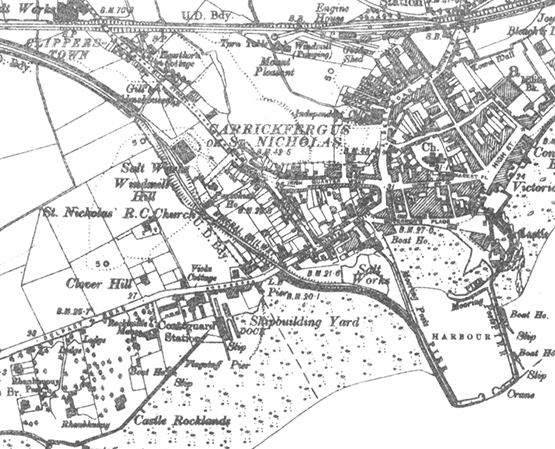
Carrickfergus around 1901. John Hilditch’s first boatyard in 1889 was in the inner harbour where it says “Boat Shed”, then in 1902 he moved to the former shipyard of Paul Rodgers immediately west of the harbour. At the time, Carrickfergus Amateur Rowing & Sailng Club (founded 1866) was in premises on the east side of the East Pier, the more northerly of the two Boat Houses.
In later life he would become Lord Craigavon, first Prime Minister of Northern Ireland in 1921. But in 1896 his prime interest was in expanding the 15ft LWL class with an up-and-coming new boatbuilder, John Hilditch of Carrickfergus. Hilditch was very much in Craig’s sights as the approved builder, as he and his men had already shown with the building of the 35ft G L Watson-designed cutter Peggy Bawn in 1894 that he could stick rigidly to the designer’s drawings, whereas Paddy McKeown, the back-street boatbuilder in Belfast who built the first three 15ft LWL boats, was notorious for always trying to improve on the designer’s original ideas.
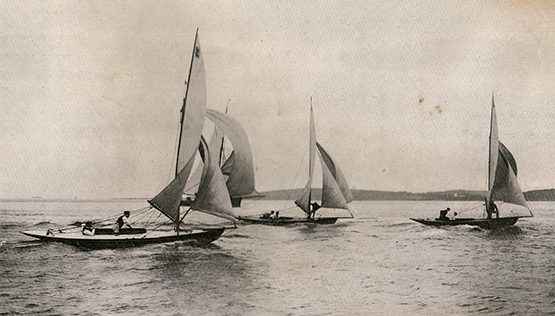
The true pioneers. The Fife-designed 15ft Belfast Lough ODs of 1896 showed the way for the 25ft LWL Class I boats in 1897.
But in the fast-moving world of Belfast in the mid-1890s. events overtook them. Several of the more affluent Belfast Lough yachtsmen had already noted with approval the able seagoing power and attractive performance of the first three 15ft LWL boats. In effect, Belfast Lough provided them with a perfect test tank, and the 15ft LWL boats were their “test models”. In a very short space of time, the heavy hitters in the BLODA had persuaded the Association to order the plans of a 37.5ft LOA, 25ft LWL boats, and thanks to the efficiency of the Hilditch Yachtyard – which in those days was only a few sheds at the head of Carrickfergus Harbour - the first eight boats of the BLOD Class I were racing. They made a huge impact in a visit to the Firth of Clyde in 1897, they went to Dublin Bay where they inspired the creation the following year of the DBSC 25ft OD, and even though at season’s end, when the weekly magazine Yachting World - in reviewing their success - described them as “a cheap knockabout class”, a laudatory report in the influential New York Times of their doings at Clyde Fortnight in Scotland was to carry them through with fresh confidence into their greatest year, 1898.
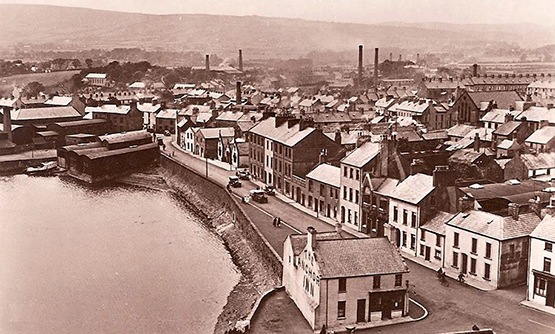
The humble birthplace. The new BLOD Class I boats were built with remarkable efficiency by John Hlditch and his team in the little boatyard in those black sheds on the inner corner of Carrickcfergus Harbour in the wintyer of 1896-97.
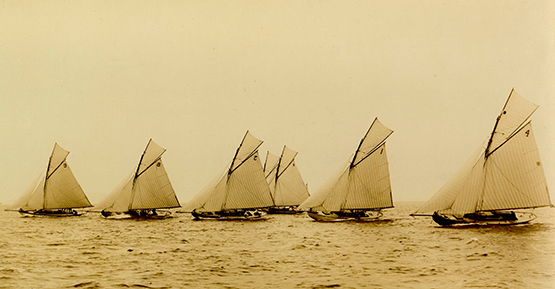
In all their glory. The BLOD Class I boats racing in full strength in 1898.
But anyone who is into Centenaries will realise that Belfast in 1898 had become a very different place from Belfast in 1798. In 1798, Belfast had been a hotbed of the United Irishmen, and one of the local leaders in The Rising, the Presbyterian Henry Joy McCracken, had been hanged with The Rising’s suppression, executed in the town centre on public land which had been donated to the citizens of Belfast by his own grandfather.
In addition to his many other interests, McCracken had been a very early pioneer in developing Belfast Lough sailing, and he and his friends cruised most summers to the west coast of Scotland. But while McCracken may have been taken, his friends lived on in an increasingly different Belfast in the early 1800s, where successful trade and manufacturing industry obliterated any earlier political idealism. Nevertheless some of those former shipmates of Henry Joy McCracken formed the Northern Yacht Club on Belfast Lough in 1820. But as Belfast port became ever more industrialised, they found it more congenial to sail on the Firth of Clyde, within a few years there was a Scottish branch, and by 1838 the Royal Northern Yacht Club of Rothesay had completely absorbed its Belfast unit, and there wasn’t to be another yacht club on Belfast Lough until Holywood yacht Club came into being beside its drying anchorage at the little County Down town immediately east of Belfast in 1862.
By the end of the 1860s, the Holywood club had been joined by the clubs at Carrickfergus and the Royal Ulster, but some years were to pass before the sport of sailing came central stage. Yet by 1898, Belfast Lough sailing wasn’t just centre stage on Befast Lough. It was world-leading. The Fife-designed One Design classes were widely admired at a time when Fife’s star was very much in the ascendant, and then in August 1898, Thomas Lipton announced his first challenge for the America’s Cup through RUYC, the actual contest to take place in New York harbour early in October 1899.
Already, there was a movement among members to build a proper trophy clubhouse for the RUYC, and Lipton made it clear he was unenthusiastic about having his challenge based on a club which was head-quartered in a semi-detached suburban house. But James Craig had a talented older brother who was an architect, Vincent Craig, and he soon had the plans drawn up for an arts & craft building which continues to dominate the Bangor waterfront today, and houses a priceless collection of yachting memorabilia, while at the same providing a convivial venue to celebrate an important Sesquicentennal.
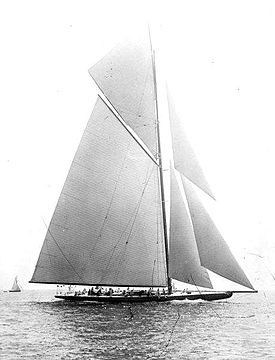
Thomas Lipton’s Shamrock IV of 1914 was one of his most promising challengers. But the outbreak of the Great War signalled the end of the Golden Era, and though Shamrock IV finally challenged unsuccessfuly in 1920, in was in very subdued circumstances.
Today, we know that none of Lipton’s Americas Cup campaigns succeeded, though some came tantalisingly close to success. Today, we know that John Hilditch’s wonderful boatyard only lasted for 24 years, and the poor man, worn down by overwork and finacial stress, died on Christmas Eve 1913. And today we know that, regardless of the turmoil within Ireland from 1912 to 1922, it was the Great War of 1914-1918 which was to wipe out the cream of an entire generation from the north of Ireland, with sports like sailing taking a very long time to recover, if they ever really did recover until much more modern times.
Yet in 1898, it was a time of such hope, such anticipation, such planning – such excitement and exuberance. It can all be captured again with the many events at Royal Ulster and Carrickfergus this summer, when in addition to the clubs’ 150th anniversaries, they’re also staging a Hilditch Regatta at Carrickfergus with a Parade of Sail to Bangor to give proper prominence to the memory of a man who contributed so much to the success of Belfast Lough sailing in the Golden Era of 1894 to 1914.
Historic Belfast Lough Boatyard Lives On Through Classic Yachts
The recreational marine industry is a demanding trade. Your customers buy boats for pleasure, so they assume it’s a fun business to work in. Thus there’s no lack of potential boat designers and builders to be found among the children of those who only sail for sport and fun, for they see that the adults enjoy being around boats, and they get to think that being around boats all the time for work and play is the only way to live.
But in the end, business is business. The bottom line rules everything else. However enthusiastic young people may have been when first going into the boat trade, as they battle on with running their own marine business they find the world of commerce can become a cruel place. W M Nixon considers the challenges of boat-building, and looks at the story of John Hilditch of Carrickfergus, who was one of the brightest stars of the Irish boat-building industry in the golden age of yachting, yet his light was extinguished after barely two decades.
The name of Hilditch of Carrickfergus is synonymous with classic yachts of significant age. John Hilditch built the 36ft G L Watson-designed cutter Peggy Bawn in 1894, and she still sails. In fact, she sails in better shape than ever, as she had a meticulous restoration completed for Hal Sisk of Dun Laoghaire in 2005.
More recently, in 2013 the Hilditch-built Mylne-designed Belfast Lough Island Class 39ft yawl Trasnagh was restored for Ian Terblanche in Devon in time for her Centenary. And in 2015, the Belfast Lough OD Class I Tern – 37.5ft LOA to a William Fife design and built in 1897 with seven sister-ships by John Hilditch - has appeared in Mallorca so superbly restored that when she went on to Les Voiles de St Tropez at the end of September, she won her class despite it being heavy weather, and she only just out of the box.
 Peggy Bawn in her first season afloat in 1894. She was built for A J A Lepper, Commodore of Carrickfergus Sailing Club, who was one of John Hilditch’s most loyal clients. Photo courtesy RUYC
Peggy Bawn in her first season afloat in 1894. She was built for A J A Lepper, Commodore of Carrickfergus Sailing Club, who was one of John Hilditch’s most loyal clients. Photo courtesy RUYC
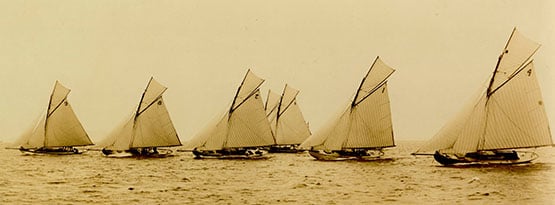
A monumental achievement. All the boats of the new Fife-designed Belfast Lough OD Class 1 of 1897 were built by John Hilditch in less than a year. Photo: Courtesy RUYC
But we don’t have to go to distant restoration specialists to find evidence of the large and varied Hilditch output. The first five boats of the Howth 17 OD class were built by John Hilditch immediately after he’d built the eight Belfast Lough Class I boats. The little new Howth gaff sloops – rigged with huge jackyard topsails as they still are today - sailed the 90 miles home down the Irish Sea to Howth in April 1898, and had their first race on May 4th 1898. All five of the original Hilditch creations continue to race with the thriving Howth 17 class, which today has eighteen boats.
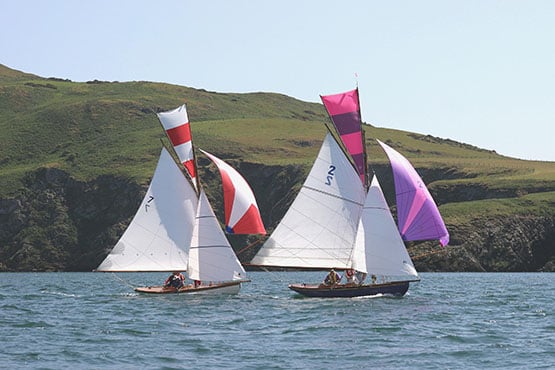
The Howth 17s Aura (left) and Pauline. Aura is one of the original five Howth 17s built for 1898 by John Hilditch immediately after he had completed the Belfast Lough Class I boats. Photo: John Deane
This concentration of yacht design development in a short time span, and through just one boatyard, is rare but not unique – the great name of Charlie Sibbick of Cowes shone equally briefly but even more brightly at much the same time, as he was a designer too. But Sibbick made his name in an established international centre for sailing. Yet when John Hilditch – who was both a seafarer and a fully-qualified shipwright – established his yard at Carrickfergus on Belfast Lough in the winter of 1892-93, the north of Ireland was still a relative backwater in international sailing terms. Thus his achievement is indeed remarkable. For by the time Hilditch closed down in the winter of 1913-14, he had put Belfast Lough firmly in the global picture as a pace-setter in yacht development, and his pivotal role in that transformation is gaining increasing recognition.
Not that there hadn’t been sailing in Belfast Lough before Hilditch came along. There are many yacht and sailing clubs around this fine stretch of sailing water, and the most senior of them is Holywood Yacht Club (on the waterfront below the hills where Rory McIlroy learned to pay golf), which dates back to 1862. And in 1866, two more new clubs came into being – Carrickfergus Sailing Club which was obviously location-specific, and the Ulster Yacht Cub, which became the Royal Ulster Yacht Club in 1869, but was a premises-free moveable feast until 1898, when America’s Cup challenger Thomas Lipton insisted it have a clubhouse, which was duly opened on an eminence close above the Bangor waterfront in April 1899.
The shared foundation year which goes back through the mists of time to 1866 means that both clubs will be celebrating their 150th Anniversaries in 2016. They’ve been quietly working on their separate plans towards celebrating this significant date, with a massive new history of the RUYC under way for a couple of years now and due for publication in the Spring, while Carrickfergus also has plans in the publication line.
Yet although there is much to write about now, in both club’s cases the pace of development was relatively slow until the late 1880s, for until that time, the business of the rapidly expanding city of Belfast was business, and more business. It wasn’t until the 1880s that leisure sailing began to get serious attention from the rapidly growing middle classes of the greater Belfast area. But once they did begin to take it up, they did so with complete enthusiasm, and the sailing pace of Belfast Lough during the 1890s, and on towards 1910, had few rivals.
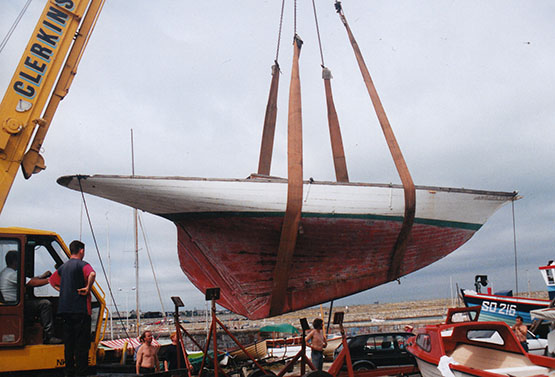
For the rapid yacht design development seen during John Hilditch’s busy years, compare this with the next image. The old-style hull of Peggy Bawn is revealed as she is lifted out of the Coal Harbour Yard in Dun Laoghaire in 1996 for a first attempt at restoration. Later, Hal Sisk took over the project, and it was completed for him by Michael Kennedy of Dunmore East. Photo:W M Nixon
 The new style shape. Although they were built only three years after Peggy Bawn, the Fife-designed Belfast Lough Class I boats had a much more modern hull shape and were primarily racing boats, yet they were required to be well capable of sailing to Scotland and Dublin Bay, and did so
The new style shape. Although they were built only three years after Peggy Bawn, the Fife-designed Belfast Lough Class I boats had a much more modern hull shape and were primarily racing boats, yet they were required to be well capable of sailing to Scotland and Dublin Bay, and did so
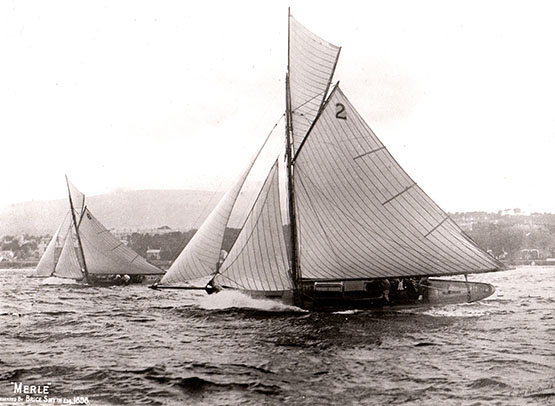 Formidable performers. The Belfast Lough Class I boats Merle (6, Brice Smyth) and Flamingo (2, John Pirrie) racing hard in 1898. Both owner-skippers were members of Carrickfergus SC, and based their boats there. Photo: Courtesy RNIYC
Formidable performers. The Belfast Lough Class I boats Merle (6, Brice Smyth) and Flamingo (2, John Pirrie) racing hard in 1898. Both owner-skippers were members of Carrickfergus SC, and based their boats there. Photo: Courtesy RNIYC
In order to meet this demand, John Hilditch was able to expand his new boatyard at an extraordinary pace. Even then, he couldn’t keep up with demand, such that one new Belfast Lough class, the Linton Hope-designed lifting-keel 17ft LWL Jewel Class of 1898, had to be built in Chester in England. And at the same time, the fishing-boat builder James Kelly of Portrush on the North Coast found that yacht-building to supply the new craze was much more lucrative than producing his own variant of the classic Greencastle yawl for fishermen on both the Irish and Scottish coasts, and he went into yacht-building both for Belfast Lough and Dublin Bay.
But in terms of overall contribution to the transformation of Belfast Lough sailing, John Hilditch was very much in a league of his own. So much so, in fact, that noted international classic sailing polymath Iain McAllister got to thinking last winter that even though no trace whatsoever now remains of this once famous yard, it was time and more for John Hilditch’s work to be celebrated, and how better than a Hilditch Regatta during 2016 to tie in with other Belfast Lough sailing celebrations?
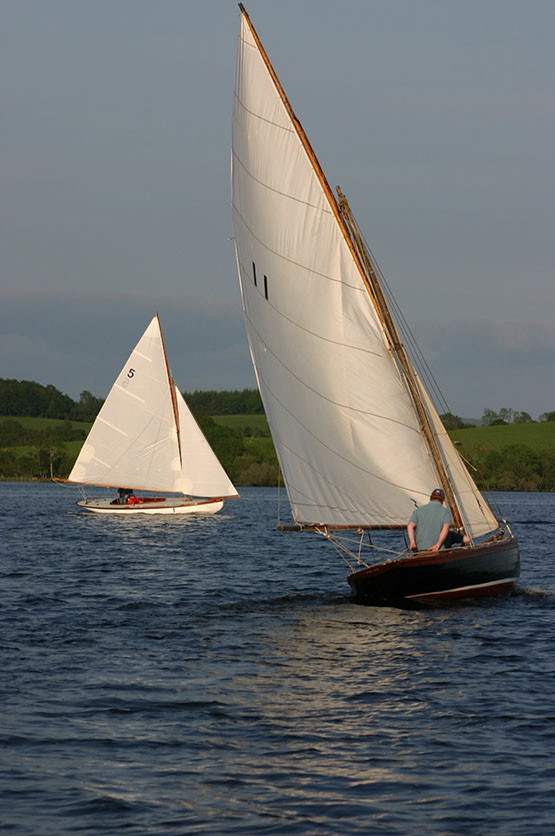
It’s a great idea which seemed almost too good to be true. But thanks to quiet work behind the scenes, most notably by Wendy Grant who recently became Commodore of Carrickfergus Sailing Club neatly in time to hold the top post during the 150th celebrations (she’s the mother of renowned offshore navigator Ian Moore), plus a special sub-committee in RUYC which likewise holds to the notion that the early stages of good work are best done by stealth, a programme is emerging which will keep all organising parties happy while providing participants with a manageable user-friendly schedule.
It has all become viable during this past week thanks to the confirmation that the more distantly-located significant classic boats of the Hilditch oeuvre – Peggy Bawn of 1894, Tern of the 1897 Belfast Lough Class I, the Howth 17s of 1898, and Trasnagh, the Island Class yawl of 1913 – all hope to be in Belfast Lough towards the end of June 2016, where numbers will be further swollen by the Hilditch-built Royal North of Ireland YC Fairy Class of 1902, together with some of their sister-ships from Lough Erne.
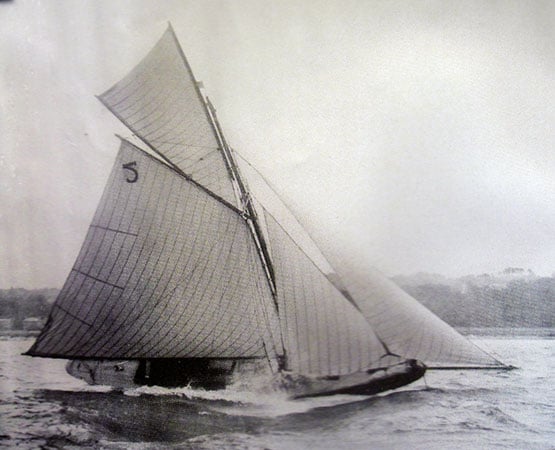
The Hilditch-built Tern in a breeze of wind on Belfast Lough, 1898
Tern in a breeze of wind at St Tropez, September 2015.
In addition, the fleet will be increased by other classics of every type, coming together to wish the Hilditch boats well at this special time. And there’ll be a goodly contingent of Irish Sea Old Gaffers which will be heading towards the big event on Belfast Lough in late June by way of the Old Gaffers Rally at Portaferry in the entrance to Strangford Lough from June 17th to 19th.
But before getting carried away by anticipation of all this festivity, let us remember that this week’s thoughts were introduced by a precautionary reminder that the boat-building trade is no bed of roses. So just what did go wrong, that the much-admired Hilditch yard faced closure before the end of 1913, with the man himself dead – perhaps broken-hearted – before the end of 1914?
There seem to be a number of explanations, all of which combine to explain the sudden demise of a great enterprise. The incredible rate of economic expansion in Belfast – which had been accelerating virtually every year since around 1850 – seems to have first shown significant signs of slackening in 1910. The greater Belfast economy did continue to expand in the broadest sense, but the rate of expansion was now slowing.
During the rapid growth years, John Hilditch was able to meet demand, but regardless of the underlying economic patterns, by 1910 his market was beginning to reach saturation levels. If people had continued to change their boats every three years or so – as they’d anticipated doing when the Belfast Lough One Design Association was established in 1896 – then an artificial demand might have been maintained. But people were beginning to realise that a good one design boat was good for much longer than a mere three years. In fact, some argued that a class was only bedded in after three years. So the number of new boats being ordered dried to a trickle.
Yet those boats that were being ordered became individually larger. When the Alfred Mylne-designed 39ft Belfast Lough Island Class yawls began to be conceptualised as the world’s first true cruiser-racer one designs in 1910, they would be far and away the biggest and most expensive one designs Hilditch had yet built. He held out for a price of £350 per boat, but the potential owners – hard-headed Belfast businessmen determined to drive a tough bargain and not to be seen to weaken – wouldn’t budge beyond £345.
In those days, yacht-building was simply priced by overall length, so Hilditch resigned himself to accepting the £345 by agreeing to build a boat with a slightly shorter bow. For all parties, it was a case of cutting off one’s nose off to spite one’s face. The new Island Class yawls were handsome enough. But with a longer bow, they’d have been beautiful.
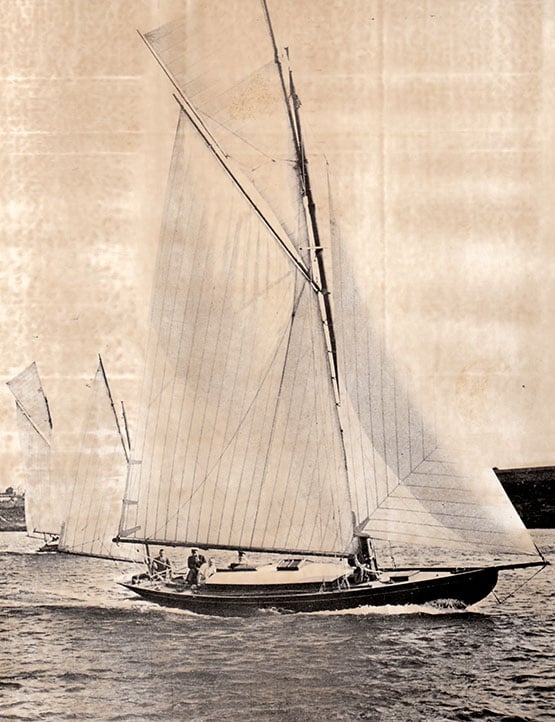 The island Class yawl Trasnagh, seen here in her first season of 1913, is believed to be the last boat to have been built by John Hilditch. Photo: Courtesy RNIYC
The island Class yawl Trasnagh, seen here in her first season of 1913, is believed to be the last boat to have been built by John Hilditch. Photo: Courtesy RNIYC
The last of them, Trasnagh herself in 1913, was the last boat to come out of a formerly great yard rapidly tumbling towards extinction. The times were restless politically as well as economically, so it wasn’t a good time to rely on building pleasure boat for a living. And apart from the saturation of the market and the financial demands of building the relatively large Island Class boats, sailing was no longer attracting the same number of newcomers, as rival interests such as motor cars and aeroplanes were taking away many potential enthusiasts,
Yet ironically, had John Hilditch been able to hang on for just another year into the beginning of the Great War of 1914-18, a slew of war work for the Admiralty would have given his yard a new lease of life. But it was not to be. The yard was gone. And soon, so too was the man himself.
But the boats live on. One hundred and two years after John Hilditch’s death, boats that he created are still sailing the seas, and their assembly in Belfast Lough from June 22nd 2016 onwards will be a reminder that, once upon a time, on a site long since covered by Carrickfergus’s re-developed waterfront, John Hilditch and his team built nearly a hundred fine yachts, the best of which have well stood the test of time. All that together with the 150th Anniversaries of two remarkable sailing clubs. For sure, late June on Belfast Lough is going to be one very special time.
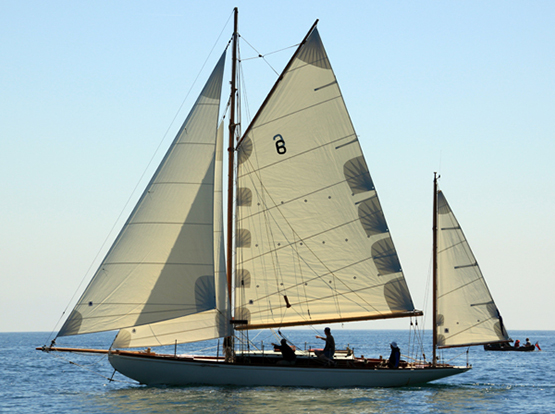
Trasnagh restored for her Centenary in 2013
#carrickfergus – Carrickfergus Sailing Club on Belfast lough is celebrating the re-opening of its newly restored clubhouse just two years after a major fire destroyed the building.
VIPs and members of the sailing fraternity from across Northern Ireland gathered at Rodgers Quay for the Grand Opening and to sample the impressive new facilities that will make Carrickfergus one of the top sailing clubs in Ireland.
The new clubhouse was opened by Terry Windsor, who is one of the best known members of the club, having joined in 1955. He is also one of the most experienced sailors and for the last five years has been Race Officer for the Clubs Points Racing.
Members of the club have worked hard over the past two years to ensure that sailing continued as normal and events went ahead despite the devastating loss of their clubhouse.
Up to seven fire appliances were called to the clubhouse at Rodgers Quay on June 23, 2012 as a major blaze swept through the building. The next morning, club members met to begin drawing up a Development Plan which would see the clubhouse fully restored.
The restored premises are better than ever with new state-of-the-art changing facilities fully accessible to sailors with a disability and a new multi-purpose room ideal for dinghy sailing. The clubhouse also features a large first floor balcony area with stunning views across Belfast Lough.
Club Commodore Trevor Kirkpatrick praised club members for their work in ensuring that the club's sailing calendar continued.
He said: "It has been a difficult two years but I am so delighted that we are back at the clubhouse that has been our home for the past 35 years. I would like to thank everyone in the sailing fraternity who rallied round and helped ensure this great club continued.
"We are immensely proud of this new building that is not only much more environmentally friendly but also has full disabled access. Carrickfergus is now very well placed to attract a host of major sailing events to our town."
Mr Kirkpatrick added: "After the fire we were struck by the messages of support we received from sailing clubs as far away as Dublin. Our members really rose to the challenge, volunteering for extra duties and helping to clear up after the fire.
""We would like to thank our neighbours including Carrick Sea Cadets, Belfast Lough Sailability, Carrickfergus Marina & Premier Inn for helping us out with use of their facilities during the time of restoration."
The Deputy Mayor of Carrickfergus, Councillor Lynn McClurg, who officiated at the re-launch, commented: "It gives me great pleasure to be here today representing Carrickfergus Borough Council and deputising for the Mayor,
Alderman Johnston, who sends his apologies as he has a prior engagement.
"It was actually our current Mayor, Alderman Johnston, who officially opened the Club when it was first built in 1984. Despite the tragic circumstances of the fire, the Club pulled together and with an immense fundraising effort, has managed to create this very valuable local community asset. All of those involved are to be highly commended for their endeavours and the analogy of the 'phoenix rising from the ashes' is entirely appropriate on this occasion."
Ronnie Brown, Chief Operations Officer of the Royal Yachting Association Northern Ireland, said: "We in the Royal Yachting Association Northern Ireland are aware of the huge effort which has gone into getting this project to completion and delighted that Carrickfergus Sailing Club, which has produced and continues to produce so many top class sailors, is now fully back in business in exciting new accommodation."
Fire Destroys Carrickfergus Sailing Club
#NEWS UPDATE - BBC News reports that Carrickfergus Sailing Club in Co Antrim has been destroyed in a fire overnight.
Firefighters were called to the scene at Rodgers Quay shortly after 11.30pm last night Friday 22 June.
No injuries have been reported in the incident, and the cause of the blaze is not yet known.
East Antrim DUP MLA David Hilditch told the BBC that the fire is "a major blow this morning for Carrickfergus".
"Obviously there will be some major disruption to our activities," said the club's Commodore Roger Woodward in a statement on the club's Facebook page.
"At this early stage the way ahead is not clear, but please be assured that the committee will be totally determined that the club will recover strengthened from this disaster."


























